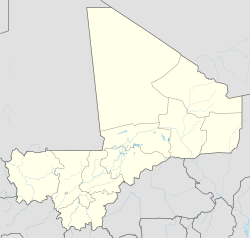Hombori
| Hombori | |
|---|---|
| Commune and town | |
 |
|
| Coordinates: 15°16′48″N 1°42′0″W / 15.28000°N 1.70000°WCoordinates: 15°16′48″N 1°42′0″W / 15.28000°N 1.70000°W | |
| Country |
|
| Region | Mopti Region |
| Cercle | Douentza |
| Area | |
| • Total | 2,923 km2 (1,129 sq mi) |
| Population (2009 census) | |
| • Total | 23,099 |
| • Density | 7.9/km2 (20/sq mi) |
Hombori is a small town and rural commune in the Cercle of Douentza in the Mopti Region of Mali. The commune contains 25 villages and in the 2009 census had a population of 23,099. The town lies just to the north of the Hombori Tondo mesa on the R15 highway linking Mopti and Gao.
Nearly all the rainfall occurs between late June and the middle of September. The mean annual rainfall in the period 1950-2007 was 372 mm but there are large year-to-year variations. The mean air temperature is 30.2 °C with the highest monthly average occurring in May (42 °C) and the lowest in January (17.1 °C). The provision of drinking water in the commune is difficult as there is no continuous aquifer which can be tapped by deep wells.
The town is known for its vernacular architecture of rock-built houses with narrow alleyways and tunnels. The area around Hombori features rock formations including the Needles of Gami and is popular for rock climbing. Mount Hombori, Mali's highest point at 1153 meters, is nearby.
Hombori is an ancient village of the Dogon people; its exact age is unknown. After the invasion of the almoravides in the 16th century, one part of the royal family of Gao established themselves in Hombori. The Songhai, now the majority population, later followed the royal refugees to this area.
Hombori remains a focus of Songhai Empire traditions but was also a strategic point for the conquest of southern Mali by the Songhai successor states.
Those local villages deeper in the hills (for example Tabi, 30 km away) were never conquered or directly colonised, and retain their traditional cultures.
The Songhai leadership were largely coopted by the French Colonial administration upon their arrival around 1900, while much of the Dogon community fled to nearby mountains, a process that had earlier begun to escape Moorish slave raids.
...
Wikipedia

